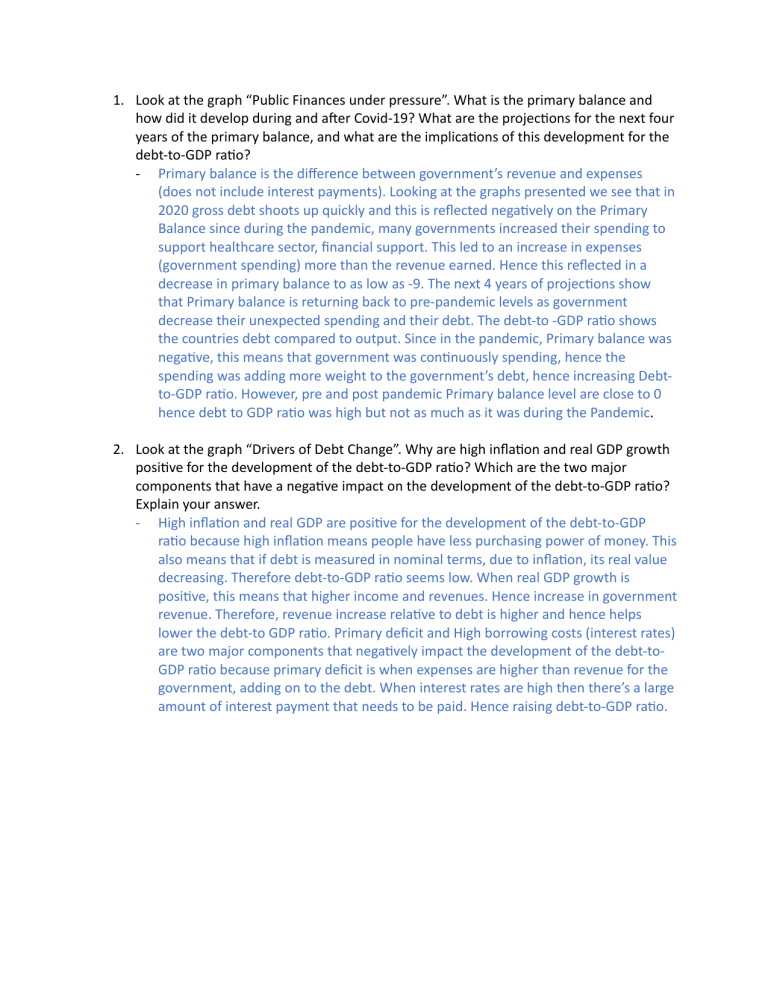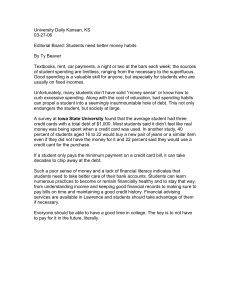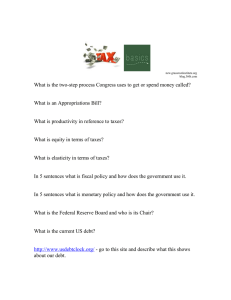
1. Look at the graph “Public Finances under pressure”. What is the primary balance and how did it develop during and a?er Covid-19? What are the projecEons for the next four years of the primary balance, and what are the implicaEons of this development for the debt-to-GDP raEo? - Primary balance is the difference between government’s revenue and expenses (does not include interest payments). Looking at the graphs presented we see that in 2020 gross debt shoots up quickly and this is reflected negaEvely on the Primary Balance since during the pandemic, many governments increased their spending to support healthcare sector, financial support. This led to an increase in expenses (government spending) more than the revenue earned. Hence this reflected in a decrease in primary balance to as low as -9. The next 4 years of projecEons show that Primary balance is returning back to pre-pandemic levels as government decrease their unexpected spending and their debt. The debt-to -GDP raEo shows the countries debt compared to output. Since in the pandemic, Primary balance was negaEve, this means that government was conEnuously spending, hence the spending was adding more weight to the government’s debt, hence increasing Debtto-GDP raEo. However, pre and post pandemic Primary balance level are close to 0 hence debt to GDP raEo was high but not as much as it was during the Pandemic. 2. Look at the graph “Drivers of Debt Change”. Why are high inflaEon and real GDP growth posiEve for the development of the debt-to-GDP raEo? Which are the two major components that have a negaEve impact on the development of the debt-to-GDP raEo? Explain your answer. - High inflaEon and real GDP are posiEve for the development of the debt-to-GDP raEo because high inflaEon means people have less purchasing power of money. This also means that if debt is measured in nominal terms, due to inflaEon, its real value decreasing. Therefore debt-to-GDP raEo seems low. When real GDP growth is posiEve, this means that higher income and revenues. Hence increase in government revenue. Therefore, revenue increase relaEve to debt is higher and hence helps lower the debt-to GDP raEo. Primary deficit and High borrowing costs (interest rates) are two major components that negaEvely impact the development of the debt-toGDP raEo because primary deficit is when expenses are higher than revenue for the government, adding on to the debt. When interest rates are high then there’s a large amount of interest payment that needs to be paid. Hence raising debt-to-GDP raEo. 3. Explain the following quote through the lens of the IS-MP-PC model. In parEcular, explain in your answer how fiscal and monetary policy complement each other to support disinflaEon. “Many countries will need a Eght fiscal stance t support the ongoing disinflaEon process – especially if high inflaEon proves mores persistent. Tight fiscal policy would allow central banks to increase interest rates by less than they otherwise would, which would help certain borrowing costs for governments and keep financial vulnerabiliEes in check.” - Since the economy is in a inflaEonary gap where output is above potenEal, government may use MP to raise interest rate and hence decrease spending. This can be complemented by using contracEonary fiscal policy, by decreasing government spending and increasing taxes. This decreasing investment spending. Both these polices are then reflected in a change in output gap and move close to the potenEal target. However, a balance between using fiscal policy to cure demand driven inflaEon and interest rate keeps borrowing cost monitored. 4. Look again at the graph. “Public Finances under Pressure”, what can you say about the borrowing behaviour of the government of the three groups of countries during Covid19? What does that tell you about the capacity of governments to absorb adverse shocks? Is that fair? - Governments increased their borrowing this can be done through issuing bonds but also borrowing through internaEonal financial markets. In the pandemic, the government set their interest rate as close as possible to 0 (0.25% in Canada) so that they can support economic stability. They had larger budget deficits, and consequently resulEng in higher debt levels. However, countries with low economic development suffered the most as developed countries had lower debt levels before entering the pandemic has be`er capacity to absorb the shocks of increased spending. Absorbing extreme shocks depends on how well the country’s fiscal rules and foundaEons are and if the country has access to internaEonal finance market. It is not fair at all because low-income countries are conEnuing to struggle to make a recovery which countries who have already achieved fiscal stability are be`er at adapEng to such shocks and recover.






